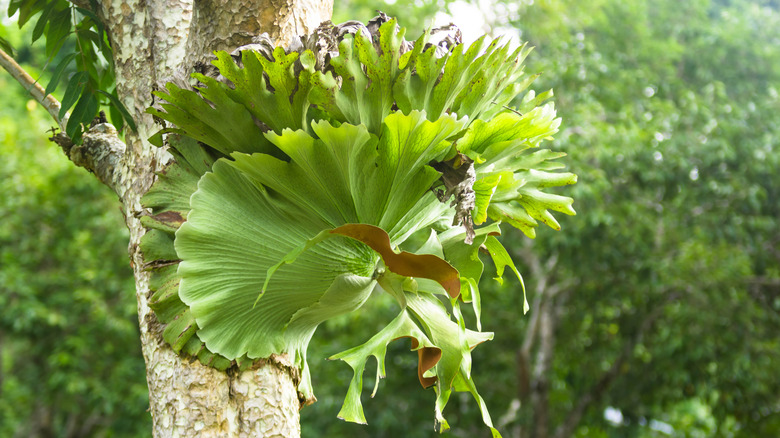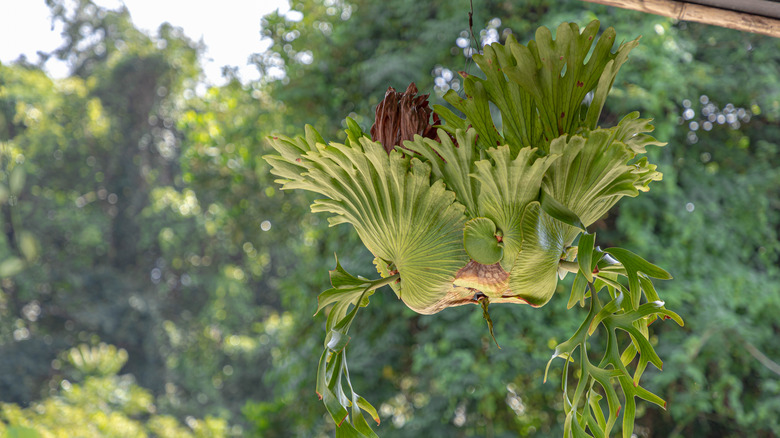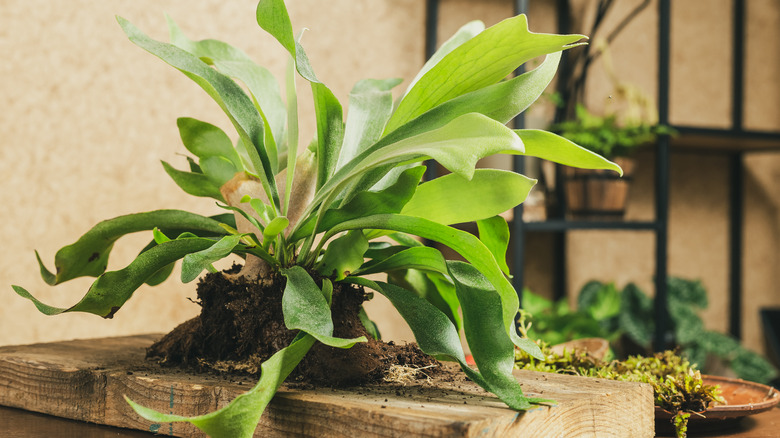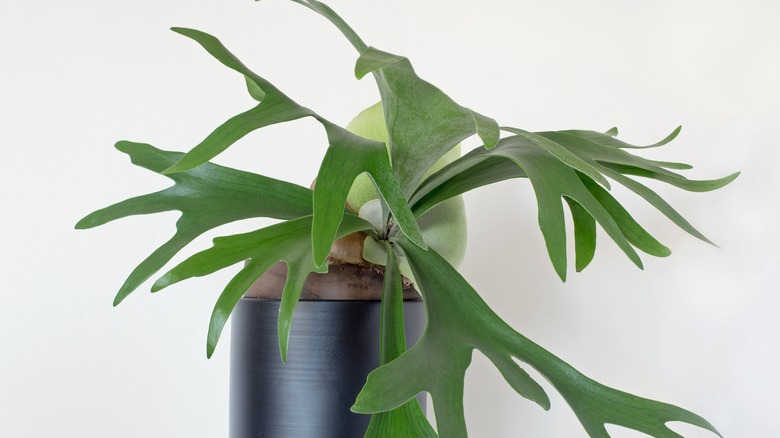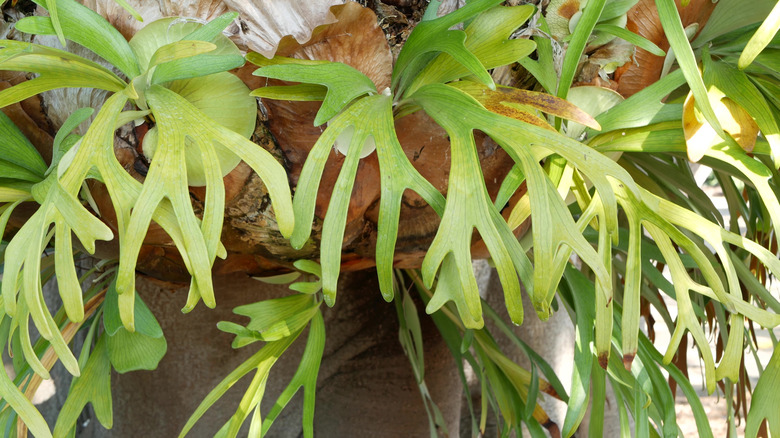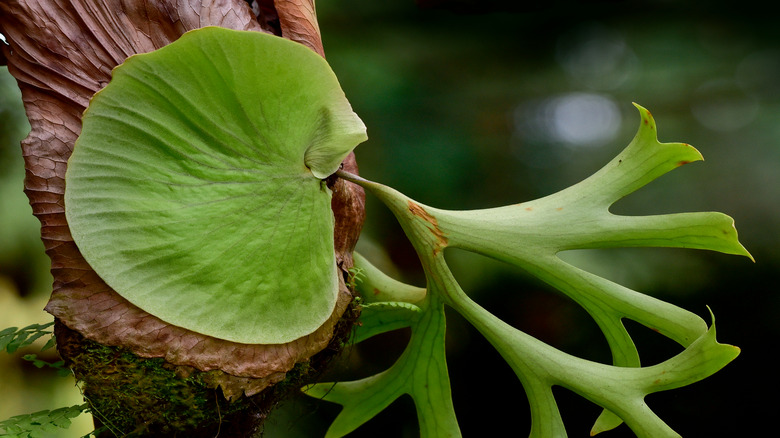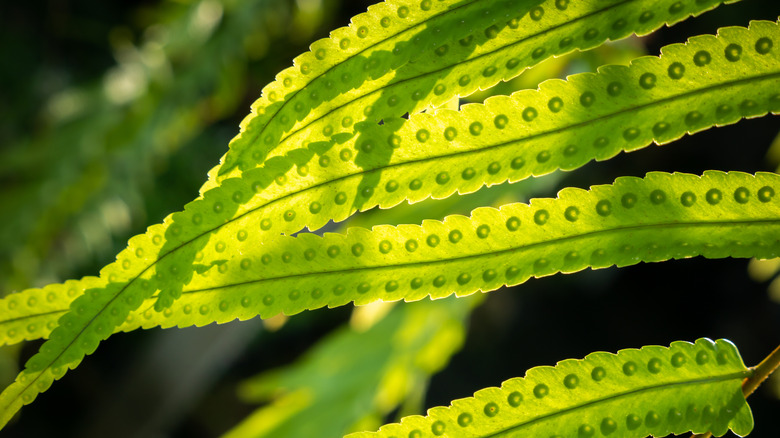How To Grow And Care For A Staghorn Fern
Platycerium, the scientific name for 18 species of staghorn ferns, has become a popular and exotic addition to both gardens and indoor settings. These non-flowering, seedless perennials are epiphytes (air plants). Generally growing on trees and rocks, they get their nutrients and water from air and rain runoff. Gardening Know How says they can weigh several hundred pounds in the wild. Some ferns have even reached 10 feet in height. Originally denizens of tropical forests in Australia, New Guinea, and Southeast Asia, staghorns have made inroads in the southeastern United States and Hawaii. Additionally, Science News reported a fascinating characteristic of staghorn ferns: A biologist postulated they form an intricate society which he likens to a termite mound. Their unique fronds function as a shared group, with each performing different jobs.
These ferns are notable for two types of leaves: flat basal ones and upper fronds — the distinctive, antler-like leaves. According to Gardening Know How, basal fronds are essential for meeting the fern's requirements. They capture moisture and nutrients from decomposing debris and provide stability for the plant. The upper fronds are for reproduction.
One note to the thrifty plant enthusiast: Certain staghorns are difficult to find and may also be expensive. On the plus side, those that are more readily available tend to be more resistant to cold and require minimal care.
How to use a staghorn fern in garden
Because staghorn ferns do not need to be in contact with soil, growing them in gardens is a unique process. In the wild they can be found on rocks, in the crotch of trees, on limbs, or attached to tree trunks. Therefore, rather than integrating them with other plants on the ground, an inventive gardener can mount them on a tree, rock, or random piece of wood. They can even be attached to your house or garage. Gardening Know How warns that the outdoor ferns will grow large, so make sure to mount or hang them where there is ample space. Also be sure to avoid shady garden areas that can get too cool.
Baskets or other hanging containers are suitable provided they are able to support the weight of these heavy plants. You may even have to use a chain for support, making sure to cushion it to protect the mounting surface. A suspended staghorn fern can act as a leafy umbrella to complement the plants below it, too.
How to grow a staghorn fern
Staghorns are considered easy to grow and care for. For the ferns to survive, it is important for the gardener to simulate the plant's natural environment. As they are tropical in origin, it stands to reason staghorn ferns prefer warm, moist conditions. A daytime temperature of at least 80 degrees Fahrenheit is optimal, with 60 degrees the minimum threshold. Relative humidity of 70% is perfect.
Specimens require bright, indirect light. Your indoor fern will welcome a stint in the bathroom or shower if it needs extra moisture. If your climate is warm enough, the staghorn can be brought outside. For best growth, it should be situated in partial shade. It is prudent to place your outdoor staghorn in a container so it can be moved inside during a cold snap.
The ferns require a growing medium rich in organic matter: humus, peat, and compost will do the trick. For growing indoors, Bob Vila suggests mounting fern cuttings on wood plaques (cedar is a good choice) to replicate the fern's growth on trees or rocks. You won't need any soil. Just cover over the roots with moistened sphagnum moss and you're all set. Secure the plant to the mount with non-copper wire. Or, grow young plants in a pot with a mixture of orchid bark and cactus potting mix.
How to care for a staghorn fern
The best way to keep your staghorn healthy is to follow proper guidelines for their nutrition and environment. According to Gardening Know How, good care requires frequent watering, but the plant needs to dry out between waterings. Fertilize your plant once every month. Experts suggest misting the basal fronds every week and watering the upright fronds should they appear wilted. Fear not if the tips are browning. These are the fern's spores, not a sign of disease. Do not over-water.
Something else to watch for are dark spots at the plant's base that may hint at over-watering and might even indicate fungal rot (Rhizoctonia). If left untreated, this fungus can be fatal, so immediately stop watering your plant. If that doesn't work, try using a fungicide. Sometimes staghorns can be infested with scales or mealy bugs. These pests can be dispatched quickly with insecticidal soap, although you may have to repeat the extermination more than once.
The ferns' outsized leaves are dust catchers. Per Gardening Know How, by washing staghorn fern plants carefully, you will remove dust that can block sunlight. Of course, doing so also brightens the appearance of the plant.
Varieties of staghorn ferns
The accepted number of staghorn species fluctuates; sometimes as many as 24 are identified. However, several of these are simply cultivated varieties of the same species. Platycerium Bifurcatum (common staghorn fern, also known as platycerium alcicorne) is the most familiar and widely known variety of the generally accepted 18 species. Indoor Plants World mentions some other notable types for the fern aficionado to choose from, which include:
- Platycerium Stemaria (triangle staghorn fern): This plant's fronds hang in the shape of long triangles. It's originally from Africa.
- Platycerium Andinum (American staghorn fern): This is a variety with shiny fronds that are hairy underneath, the only species native to the Americas.
- Platycerium Coronarium (crown staghorn): Native to Australia, it has a gold tint.
- Platycerium Elephantotis (elephant ear staghorn): Now found in the southeastern United States, it's originally from Indonesia and Papua New Guinea.
- Platycerium Insulare (flat-edged staghorn fern): This is an Australian variety that can reach 3 feet in height.
Are staghorn ferns toxic?
Some species of ferns can cause issues, but staghorn ferns are considered by the ASPCA to be non-toxic to dogs, cats, horses, and humans. However, in the unlikely event your pet has an adverse reaction to consuming or even rubbing against one of these plants, nausea, drooling, or diarrhea will alert you to the problem. Be sure to consult your vet.
Fortunately, animals and children are not easily tempted by these ferns, as the plants are frequently mounted or hung. It is also conceivable, but rare, that spores released and ingested by animal or human might cause mild symptoms of toxicity. Plant Addicts mentions a type of fern called the bracken (not a staghorn), that is toxic to cattle, sheep, and horses.
Placed indoors, the relatively harmless staghorn will actually help you. Its leaves and roots serve as an air purifier and will remove potentially toxic gases from the environment.
Three ways to propagate staghorn ferns
Growing staghorn ferns in the garden is thought to be very time-intensive. To that end, Gardening Know How suggests the following alternatives. In summer, when spores under the fronds darken, remove a few of the leaves and dry in a paper bag. Then brush the spores off, wet a clump of peat moss placed in a container, and press the spores into the surface. Make sure not to bury them. Cover with plastic and place the container in a sunny window. Water from underneath, and voilà! In three to six months, the spores will sprout and months later you will have a new plant to mount.
An alternative is to cut a mature fern in half (using a serrated knife), making sure to keep enough fronds and roots on each side. A third option: You can also remove an offshoot pup from the parent plant and attach it to its own mount.
